This article is in a series designed not to provide ‘A N Other’ opinion about a chef’s output, to be lost in the now sea of increasing ‘noise’ about top end dining. In this article the chef will analyse four of their signature dishes against aspects of the five criteria used by Michelin for awarding a Michelin star. As a reminder the five criteria were explained in an interview with Michael Ellis (at the time WW Director of Michelin Guides) and are given below.
The first and most important criteria is the provenance of ingredients; all great cuisine starts with great product – the actual product itself is considered for freshness, quality, flavour and texture and so on. The second criteria is mastery of cooking technique. The third criteria is equilibrium and harmony in flavours. The fourth criteria is regularity (or consistency) and this means starter, main and dessert are each of the appropriate standard and that each are also consistent over time. Finally, value for money is the fifth criteria.
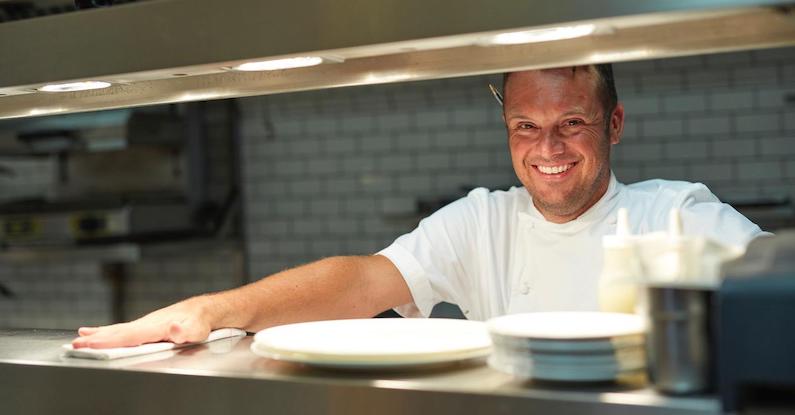
[Chef Gary Foulkes, Angler Restaurant which has a Michelin Star]
There was no romantic epiphany for Gary when it came to becoming a chef as a career. There wasn’t, for example, a childhood cooking moment, sitting on a grandmother’s knee that enamoured him with the process of preparing food. It was more a case of serendipity that through a school work experience placement, he was sent to spend a week in a hotel. Each day would see a different department – reception, bar, housekeeping and so on – the last day was spent in the kitchen. Gary found the kitchen to be the most interesting of all, exhibiting a real team atmosphere, where the chefs were all focused on what they were doing, while still managing to have a good time.
After leaving school in the mid 1990s, Gary joined the Chester Grosvenor as a commis chef before moving to a Gary Rhodes outpost in Manchester. Some while later, a journey south saw him invest time at Lords of the Manor under John Campbell, before some time later returning to John’s stewardship as sous chef at The Vineyard near Newbury. In between, Gary was in London with a stint as a chef de partie under Richard Neat at the Oxo Tower and then for two years as a chef de partie for William Drabble at Aubergine.
Most recent prior to Angler, Gary found an eight-year home at the iconic The Square restaurant under Phil Howard. Indeed, The Square tenure was split by some time spent travelling, the return prompted by a call from Phil (Howard) after the departure of his then head chef, Rob Weston, to La Trompette. Gary returned as head chef alongside Phil at the two Michelin star institution.
Gary is not the first chef interviewed by fine dining guide to speak highly of the sheer natural instinctive cooking talent of Rob Weston. While it was a potentially daunting proposition to take on, Gary quickly adapted to his elevated role at The Square. Gary and Phil remain good friends to this day, speaking regularly.
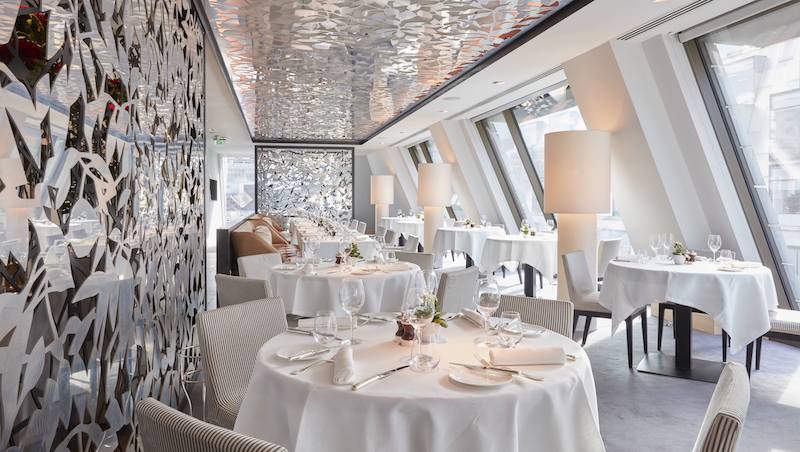
[Angler Restaurant, dining room, 7th Floor South Place Hotel, London]
Angler Restaurant, as the name suggests, has an emphasis on fish and seafood and is situated on the 7th floor of The South Place Hotel. Moorgate based and boasting a heart of the city location, the site represents the first departure by D&D Group into hotels and with Angler, the only current Michelin starred restaurant in their group. Gary Foulkes has headed up the kitchen since 2016 and thereafter successfully retained the Michelin accolade. The dining room is bright, light, airy and has a welcoming atmosphere with a gentle buzz on a weekday lunch time, ably assisted by the polished front of house operation.
Gary Foulkes now discusses how each of a selection of four signature dishes are created by those Michelin criteria for stars. This will entail a discussion in terms of cooking technique and balance and harmony on a plate for each dish. The selection of quality ingredients and provenance is also reviewed in the context of the broader menu offerings. This will be supplemented by a general overview of how consistency across the menu and over time is achieved.
The first dish is the mackerel tartare, oyster cream, apple and shiso. The dish provides a natural opener to the tasting menu as it is fresh, clean, light, visual and a delicious start to the meal. The mackerel is sourced from Cornwall and like all pelagic fish (mid-Ocean) they are at their best in autumn and winter. Fish and shellfish are sourced (including lobster) from Cornwall with langoustines and scallops arriving from Orkney and live crabs from Dorset. Where appropriate fish is line caught and this quality makes a substantial difference to taste and texture. Having long standing relationships with suppliers of fish and seafood is vitally important as it allows a mutual respect and bond of trust to develop. This ensures that Gary always has the right product at the right time at the right price for his menu requirements.

[mackerel tartare, oyster cream, apple and shiso]
In terms of cooking techniques, the first process is to brine the mackerel which has the impact of firming up the flesh. This prevents the tartare from disintegrating on the fork, while providing a similar eating texture to a traditional beef tartare. After filleting and chopping, a binding process of a little crème fraîche, shallots, lemon zest and white soy – the white soy is used instead of salt for seasoning. This avoids partially curing the fish and therefore helps assure a consistent product. Oyster mayonnaise, seaweed, shiso and apple bring a mixture of iron, tartness and fragrance to lift, cut and bring together a balance and harmony to the dish.
The second dish is Newlyn cod, caramelised parsley root, line caught squid and chanterelles. Gary is self-described as pedantic in all aspects of sourcing, preparation and cooking and so requires 6-8kg cod for the purposes of this dish. The cod is filleted, brined and air dried as the texture is vitally important. Should the cod fillet arrive at the table already split (with gaps in the flesh,) it is a sure sign of overcooking. The approach is to have it flake on the customer’s knife. The squid is scored then sits in grapeseed oil for half an hour before cooking. The dish is a stable all year-round concept with the garnish rotating throughout the seasons. In winter it is a caramelised parsley root with chanterelles but in summer it would be cauliflower purée with girolles or in spring with peas and morels.
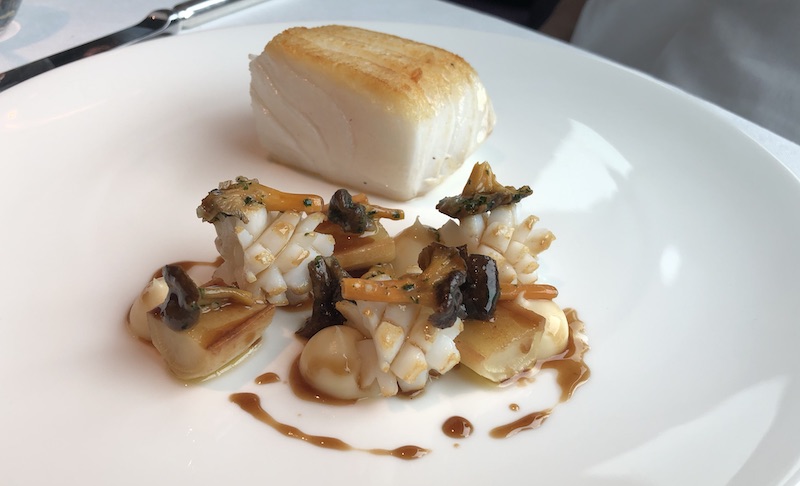
[Newlyn cod, caramelised parsley root, line caught squid and chanterelles]
As a fairly robust fish, cod is a great vehicle for flavour, so will tolerate a broader span of accompanying harmonious flavours, that will equally provide equilibrium on a plate. The extension of this observation is that it naturally facilitates seasonality. In terms of provenance, the world may have become a smaller place, but seasonality is still a key factor in Gary’s thinking. This philosophy is given the additional mantra of seeking out the best, not just the local. “If I want a white peach, I’ll source it from Italy but in terms of fish, I genuinely believe British fish is the best you can get,” observes Gary.
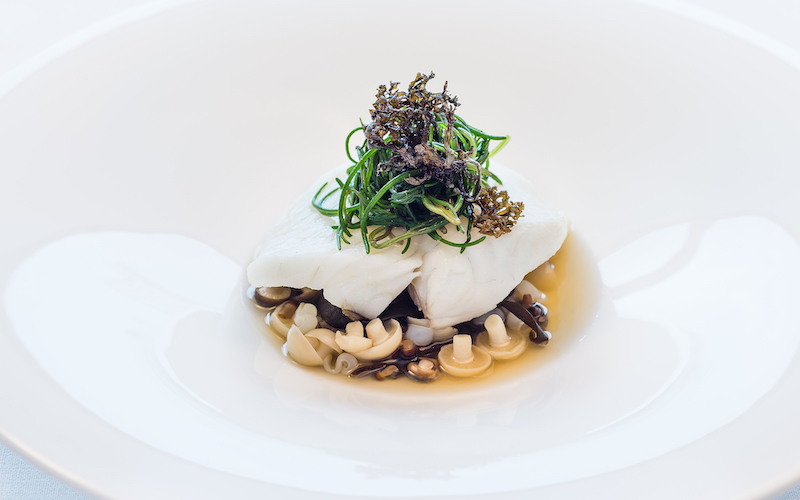
[Wild turbot, razor clams, Japanese mushrooms and katsuobushi.]
The third dish is the Wild turbot, razor clams, Japanese mushrooms and katsuobushi. Gary spent time travelling in Japan. On one evening, he tried the most amazing dashi and the chef kindly gave him the recipe. When Gary came back as head chef at The Square the turbot dish was introduced using key elements of this discovery. Over the years, the recipe and cooking times have been tweaked to perfect the Turbot dish as it stands on the menu today. The Turbot are sourced at 3-4kg to give a thick fillet. The fish is wrapped in Kombu and steamed at 78 degrees to provide a pearlescent finish. The flavour enhancement impact is beautiful in combining a form of richness and mild salty infusion. Some dashi is set using a vegetable gel to allow a layer of what looks like skin to sit over the top of the presented fillet. A poached Japanese mushroom broth is combined with slow cooked razor clams and a black squid ink noodle. A jug of dashi is offered on the side to finish the dish at the table.
Regardless of volume of customers, every guest should receive the same product. To allow consistency to come more readily, there are specific recipe books and processes – including taste filters by Gary and his sous chef Mark – right down to the vinaigrette with the scallops. A recipe is always specific, not the juice of two lemons but the exact grams or precise measures that may be required. There is no hiding place in a brigade of 10 chefs and pre-preparation is also vital to consistency. Adaptations to any menu or recipe have a collective creativity and a process to their adoption.
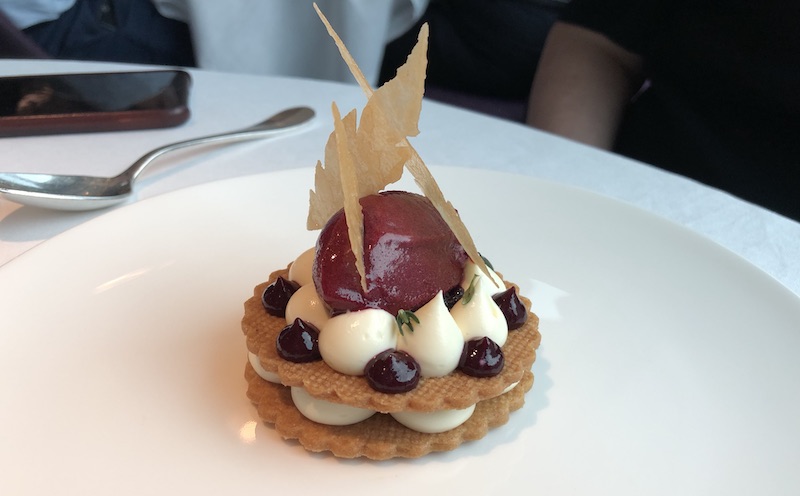
[Blackcurrant sable, wild thyme, Brillat Savarin cheesecake cream and vanilla]
The Blackcurrant sable, wild thyme, Brillat Savarin cheesecake cream and vanilla dessert is another dish that has a basic framework with elements rotating throughout the seasons. Gary might provide the original ingredients that a dish might contain then a collective and iterative effort ensues in reaching the end product. In summer it was white peach and lemon verbena, in spring it was strawberry, black olive and Greek basil and so on. Gary is particular about creating a wow factor with desserts as he says, “Nobody has a dessert because they think it’s healthy for them, they have it because they want something delicious,” and “Fruit, an element of cream, richness, crunch and zingy-ness are all elements to a great dessert” reflects Gary.
Overall, Angler restaurant has formed a significant gastronomic landmark in the city, in the able hands of Gary Foulkes, serving an ever growing, discerning and appreciative clientele. A point of note is that two key mentors have held the accolade of two Michelin stars, with the food sampled at Angler worthy of such comparisons. While Gary has clearly grown as a chef thanks to his travels both globally and within the Michelin firmament, his individual creative style leads to a polished finished article. No doubt Gary Foulkes, his kitchen and welcoming front of house teams will continue to push forward and fine dining guide looks forward to returning soon.



